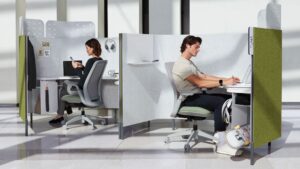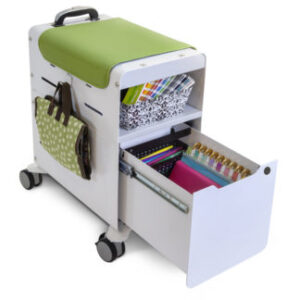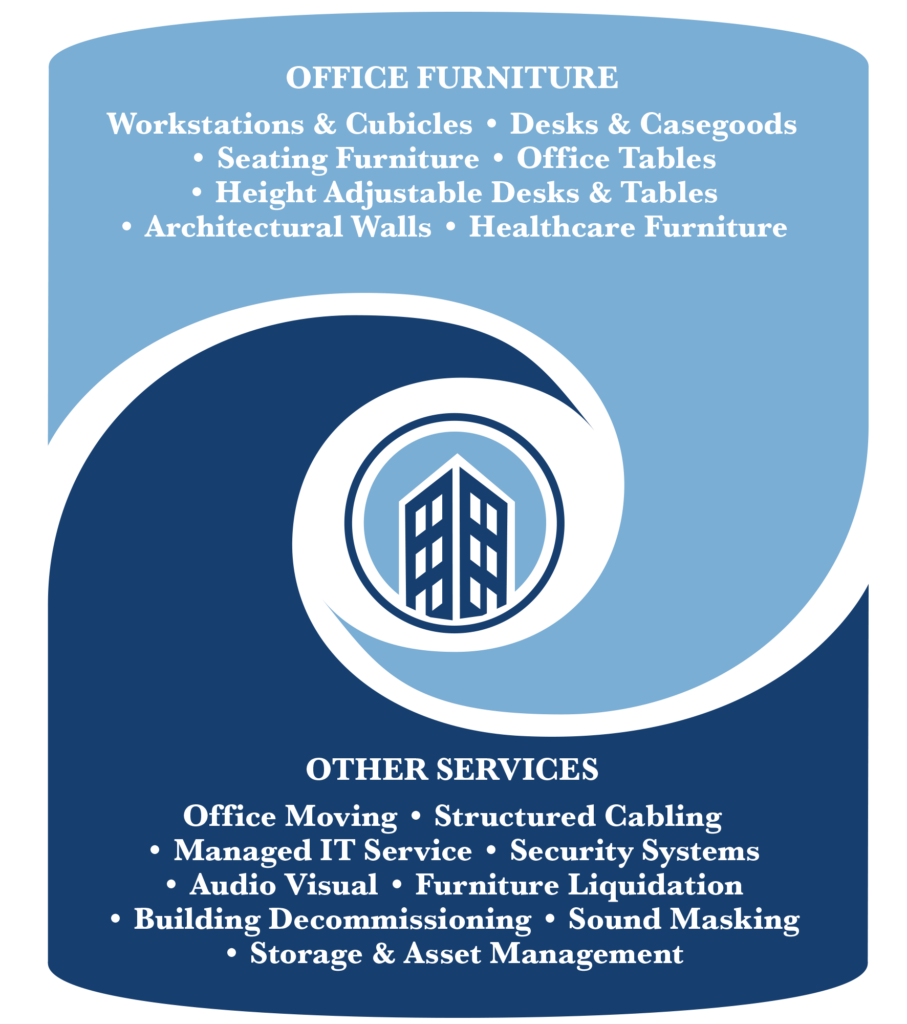19 Jul Creating a Flexible Workspace in the Modern Office
Introduction: The Importance of Adaptability in The Modern Office
In today’s rapidly evolving business landscape, the ability to adapt and respond to change is crucial for success. The traditional, rigid office environment is quickly becoming a relic of the past, as forward-thinking companies recognize the need for a more flexible and dynamic workspace. Even with the move toward open space environments and structured cubicle workstations with pockets of collaboration – often no more than a few conference rooms – this has proved to be less than optimal for many businesses post-Covid. Adaptability is no longer a mere buzzword, but an essential requirement that can give your organization a competitive edge.
As the nature of work continues to evolve, with the rise of remote work, flexible schedules, and collaborative technologies, the modern office must evolve to meet the changing needs of employees and the business. By embracing adaptability and creating a flexible workspace, you can foster a more engaged, productive, and innovative workforce that is better equipped to navigate the challenges of the 21st-century workplace.

Benefits of Creating a Flexible Workspace
 Implementing or enhancing flexible workspace in your office can provide a multitude of benefits for both your employees and your organization. Some of the key advantages include:
Implementing or enhancing flexible workspace in your office can provide a multitude of benefits for both your employees and your organization. Some of the key advantages include:
- Increased productivity: By giving employees the freedom to choose their preferred work environment, whether it is a quiet, focused area or a collaborative, open-concept space, you can enable them to work more efficiently and effectively.
- Enhanced employee satisfaction: Flexible workspaces cater to the diverse needs and preferences of your team. Promoting a sense of autonomy and empowerment can lead to higher job satisfaction and reduced turnover.
- Improved collaboration and creativity: Flexible spaces that encourage interaction, idea-sharing, and cross-functional collaboration. This can foster a more innovative and creative work culture in your office.
- Reduced real estate costs: By optimizing your office layout and utilizing shared or multipurpose spaces, you can potentially reduce the overall square footage required. This leads to significant cost savings and/or continued growth in your existing office.
- Adaptability to change: A flexible workspace design allows you to easily reconfigure and adapt your office to accommodate changes. Team size, project requirements, or business needs often can be accommodated without the need for major renovations. Additionally, it allows your teams to orient their efforts according to what works best for their projects.
Examples of Flexible Workspace Designs
 Flexible workspaces can take many forms, each tailored to the unique needs and preferences of the organization. Here are a few examples of flexible workspace designs:
Flexible workspaces can take many forms, each tailored to the unique needs and preferences of the organization. Here are a few examples of flexible workspace designs:
- Activity-based working: This approach provides a variety of work settings. Private focus areas (aka privacy booths), collaborative hubs, and informal lounges are some examples. This approach allows employees to choose the environment that best suits their current task or mood.
- Hotel desking: In a hotel desking setup, employees do not have assigned, permanent workstations. Instead, they can choose from a pool of available desks or workspaces on a first-come, first-served basis, encouraging mobility and collaboration.
- Zoned layouts: Dividing the office into distinct zones, such as quiet zones, social zones, and team-based areas, can create a more dynamic and adaptable workspace. Catering to different work styles and needs is a positive outcome. This endeavor can be enhanced through the use of technology such as sound masking systems.
 Modular furniture: Utilizing modular furniture, such as movable partitions, height-adjustable desks, and reconfigurable seating, allows you to easily rearrange the office layout to suit changing requirements.
Modular furniture: Utilizing modular furniture, such as movable partitions, height-adjustable desks, and reconfigurable seating, allows you to easily rearrange the office layout to suit changing requirements.- Hybrid work environments: Combining both physical and virtual elements, hybrid work environments enable a seamless transition between remote and in-office work, providing employees with the flexibility to work from anywhere.
Tips for Implementing a Flexible Workspace
Transitioning to a flexible workspace can be a significant undertaking, but with the right approach, you can ensure a successful implementation. Here are some tips to consider:
- Assess your current needs: Carefully analyze your organization’s work processes, team dynamics, and business goals. Identify the specific requirements and pain points that a flexible workspace can address.
 Engage your employees: Involve your team in the design process, gathering their feedback and preferences. Create a workspace that truly meets their needs and supports their work styles. No office is the same and there are always unique features needed. A highly mobile and remote workforce will need personal storage and lockers different than a highly office-oriented workforce.
Engage your employees: Involve your team in the design process, gathering their feedback and preferences. Create a workspace that truly meets their needs and supports their work styles. No office is the same and there are always unique features needed. A highly mobile and remote workforce will need personal storage and lockers different than a highly office-oriented workforce.- Prioritize adaptability: Design your workspace with the future in mind. Ensure that it can be easily reconfigured and adapted to accommodate changes in team size, technology, or business requirements.
- Invest in the right tools and technologies: Equip your flexible workspace with the necessary tools and technologies. Collaboration software, mobile devices, and cloud-based platforms enable seamless remote and in-office work. Optimally, your employees should see little to no difference in how they access systems and interact regardless of location.
- Foster a culture of adaptability: Encourage a mindset of flexibility and adaptability among your team. Provide training and support to help employees navigate the new work environment and embrace the benefits of a flexible workspace.
How to Foster a Culture of Adaptability in the Workplace
Cultivating a culture of adaptability is crucial for the long-term success of your flexible workspace. Here are some strategies to help foster this mindset:
- Lead by example: As a leader, demonstrate your own commitment to adaptability. Embrace change, be open to new ideas, and model the behaviors you want to see in your team.
- Encourage experimentation: Create an environment that celebrates, and rewards calculated risk-taking, allowing your team to explore new ways of working and continuously improve.
- Provide training and development: Invest in training and development programs that help your employees develop the skills and mindset needed to thrive in a flexible, adaptable work environment.
- Celebrate successes and learn from failures: Recognize and celebrate the successes of your team. Foster a culture of psychological safety that allows for open discussions about failures and lessons learned.
- Continuously gather feedback: Regularly solicit feedback from your employees. Use their insights to refine and enhance your flexible workspace and adaptability initiatives.
Tools and Technologies for a Flexible Workspace
Leveraging the right tools and technologies is essential for creating and maintaining a successful flexible workspace. Some key tools and technologies to consider include:
- Collaboration software: Tools like Microsoft Teams, Slack, or Google Workspace that enable seamless communication, file sharing, and project management across remote and in-office teams.
- Cloud-based platforms: Cloud-based productivity suites, document management systems, and enterprise resource planning (ERP) software that allow for anytime, anywhere access to critical data and applications.
- Videoconferencing and virtual meeting solutions: Platforms like Zoom, Microsoft Teams, or Google Meet that facilitate virtual meetings, presentations, and team interactions. Having in office audio visual systems readily available for those that are present there can be immensely helpful.
- Workspace management software: Tools that help you optimize and manage your flexible workspace, such as desk booking systems, meeting room scheduling, and space utilization analytics.
- Mobile devices and accessories: Laptops, tablets, and smartphones, along with accessories like wireless keyboards, noise-canceling headphones, and portable chargers, to enable mobility and flexibility.
Challenges and Solutions for Creating a Flexible Workspace
While the benefits of a flexible workspace are numerous, there may also be some challenges to overcome. Here are a few common challenges and potential solutions:
- Cultural resistance to change: Address any resistance to change by clearly communicating the benefits of a flexible workspace and involving employees in the transition process.
- Concerns about productivity and accountability: Implement clear performance metrics and communication strategies to ensure that employees remain engaged and productive, regardless of their work location.
- Lack of physical space or infrastructure: Explore creative solutions, such as shared workspaces, hoteling, or modular furniture, to maximize the use of your available office space.
- Cybersecurity and data privacy risks: Implement robust security measures, such as secure VPNs, multi-factor authentication, and data encryption, to protect sensitive information in a flexible work environment. Where you may not have inhouse IT capabilities to address these issues, consider hiring an MSP that will assist in the implementation.
- Challenges with team cohesion and collaboration: Foster a sense of community and connection through regular team-building activities, virtual social events, and collaborative project management tools.
The Future of Flexible Workspaces
As the workplace continues to evolve, the demand for flexible, adaptable work environments is expected to grow. Experts predict that the future of office design will place even greater emphasis on:
 Hybrid work models: Seamlessly integrating remote and in-office work. Allowing employees to choose the location and work style that best suits their needs will become the norm.
Hybrid work models: Seamlessly integrating remote and in-office work. Allowing employees to choose the location and work style that best suits their needs will become the norm.- Increased emphasis on employee well-being: Flexible workspaces that prioritize the physical and mental well-being of employees. Features like wellness zones, quiet rooms, and ergonomic furnishings will be the expectation.
- Sustainability and environmental consciousness: Flexible workspaces that incorporate sustainable design principles. Energy-efficient building materials, renewable energy sources, and waste reduction strategies are but several examples.
- Technological integration: Continued advancements in collaboration tools, automation, and artificial intelligence to enhance the flexibility, efficiency, and user experience of the modern office.
- Adaptability as a core competency: The ability to adapt and respond to change will become an increasingly valuable skill. At the individual and organizational level, the pace of change in the workplace will demand adaptability.
(Images Sourced from Pexels)
Conclusion: Embracing Adaptability for Success in The Modern Office
In the ever-evolving landscape of the modern workplace, the power of adaptability cannot be overstated. By creating a flexible workspace that caters to the diverse needs and preferences of your team, you can unlock a world of benefits, from increased productivity and employee satisfaction to enhanced collaboration and cost savings.
Ready to take the first step towards making your office more flexible? Contact our team of office furniture experts today to learn more about our comprehensive services and how we can help you navigate this exciting evolution.
MyOffice has over 20 years of experience in supporting client’s implementing office solutions. We understand the needs of the modern office environment. Enhancing office flexibility and better supporting employees in this new era is a paramount concern. We are here to help!

